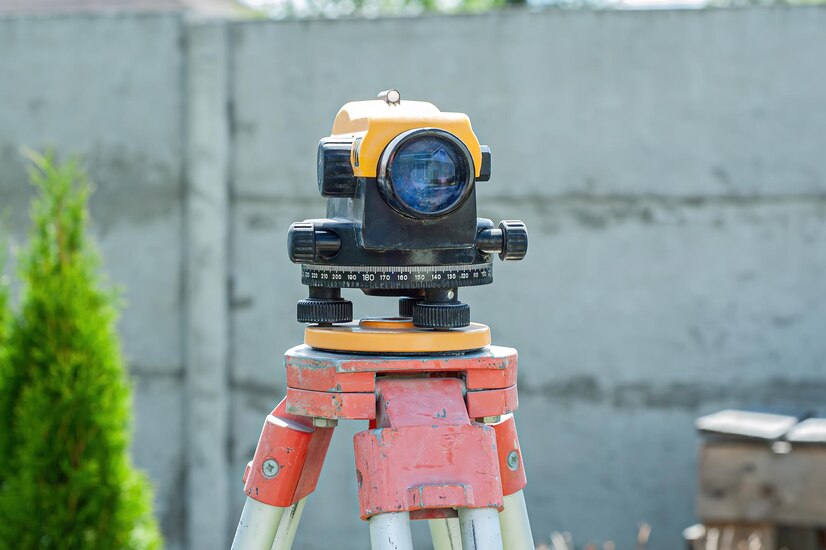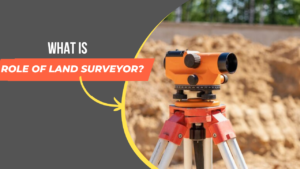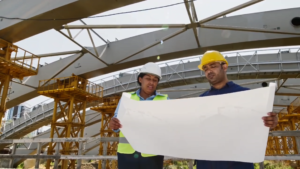An electronic theodolite called a total station measures angles and separations between sites. It is now the most cutting-edge surveying tool and can measure both horizontal and vertical angles to within three seconds.
An angle sensor, also known as a right-angle optical prism, and a digital distance metre, both of which are used during surveying, are connected to a total station. The angle sensor detects the horizontal or vertical angle.
This equipment may make several measurements, just as the name “total” implies; a total station is a telescope that is mounted on wheels or a tripod.
It can calculate the lengths and angles of lines, the heights of points on an object, its area and volume from its sides, the angle between two directions on the ground, and many other things.
Survey Instrument Types
A survey instrument is a tool used to measure things like landmass, angles, and elevations that are difficult to see with the human eye.
It offers details for every location in the form of two mathematical equations. As a result, this data may be combined with current or upcoming data to offer fresh perspectives on each location’s qualities.
Instruments used in land surveying or engineering are categorised as surveying instruments. On the ground, distances and heights may be measured using land surveying equipment, which can also measure horizontal angles.
When using engineering tools, you normally sketch or create the thing being surveyed using straight vertical or horizontal lines from a starting point.
Total Stations, Surveyor’s Benchshocks, Precision “odometers” or Flowmeter Tanks, and Surveying Laser Rangefinders or Messmarkers are some of the associated surveying tools. These devices may be installed almost anywhere on your property, including domestic-sized spaces like a house.
How does T.S Works
For surveying and mapping, total stations are employed. A complete station is a collection of synchronised gunsights, telescopes, convergence sights, inclinometers, periodic dials, and a compass that connects to a GPS receiver’s data connection port to enable the quick collection and transfer of bearing information.
Modern remote sensing techniques, such as surveying, employ technology to send data from space. It is mostly employed in the creation of maps and building surveys.
Total stations are equipment that may be placed on the ground and use various sensors to measure distances, angles, areas, heights, slopes, and find items.
The quality of the surveying equipment employed greatly affects the precision and resolution of this data. Today’s most trustworthy perspective is based on calculating points on an aerial LiDAR scan.
At Colgate University in Hamilton, New York, Thomas Edison introduced the first total station that is still in use today in 1881. A complete station is currently widely used in commercial building surveys because of its economic effectiveness.
A complete station combines a sensor and software that determines position data using spatial knowledge. Multiple sensors, such as a GPS receiver, triangulation, or short-range radio communications, can be used as sources.
Total stations are used in action taking and photogrammetry for surveying to take precise measurements of things like angles and distances. This makes it possible to digitally capture their photographs. Crop production measurement and crop classification are two other uses.
Depending on the equipment they are equipped with, total stations can measure distances up to 8 miles.
A total station is a surveying tool that provides height and distance measurements throughout a field survey using data produced by digital and radar receivers. They are used with GPS-assisted accuracy for angular geometry, horizontal distance, and vertical location.
Total station operation in a surveying context
Instead of two dimensions, as was typically the case with surveying tools, the complete station enables surveyors to produce a map of a location in three dimensions.
The name “1-Point” refers to this capacity; each point measured by a complete surveying method is referred to as one dimension and designates a distinct location on the ground. A total station’s lenses, movable vertical laser levels, and bubble axes give it exceptional precision and range.
A tool for surveying is the complete station. To determine the levels and distances of the sites it is set over, the equipment largely depends on geo-radar and time signals.
The prism is used to calculate the angles involved in triangulation and quick placement and is used to measure the heights or sections of the objects.
The complete station is used for a wide variety of engineering and construction-related tasks in surveying.
The use of the total station is widespread, including in the fields of civil engineering, architecture, site engineering for building projects, traffic engineering, and airport planning. In addition, transportation management systems make use of it.
Different Types Of Total Station
- Scanning Total Station
- Robotic Total Station
- Auto-lock Total Station
- Total Mechanical Station
Uses Of Total Station :-
Total stations and paired wire level distance measuring tools are the most frequently used surveying tools.
Land surveying is the foundation of real estate, engineering, and other professions because surveying tools give an exact picture of any property, borders, and vegetation. These surveying methods are sometimes referred to as “stations” because of how simple they are to operate.
A surveyor can measure elevation, level, angle, and distance at a specific location using a total station. A tool used to establish horizontal and vertical data in a specific region is the total station. With options ranging from small, portable devices for public use to sizable, mobile total stations often employed for long-term surveying or construction, these instruments may be tailored to the field of survey.
An instrument used by surveying professionals to chart heights and distances is called a total station. It is made up of a telescope, Vernier scales, and a coordinate system for determining the relative vertical location. The company’s brand total stations, transit total stations, and handheld total stations are the most frequently used varieties.
Advantage Of Using Total Station :-
Many client benefits are now incorporated into surveying with a complete station as a result of technological improvements. Making contour maps using straightforward measurements and computations is one benefit.
Another advantage is that surveys take less time since they don’t have to repeat the time-consuming procedure of measuring angles and distances. Processes like this can be used in surveys to increase precision and get rid of inaccuracies.
The numerous characteristics of total stations, including data collection and analysis, are advantageous to customers. This capability gives firms access to faultless and precise survey data collection, which results in considerable cost savings and raises the possibility of receiving reliable information.
A client is frequently perplexed about how to carry a complete station while using it for the first time, such as when setting up aerial photography.
He should first calculate the weight of the whole station based on the hardware weight, net weight, and volume capacity of the items that it holds in order to respond to this question and make his work run more easily and efficiently.




